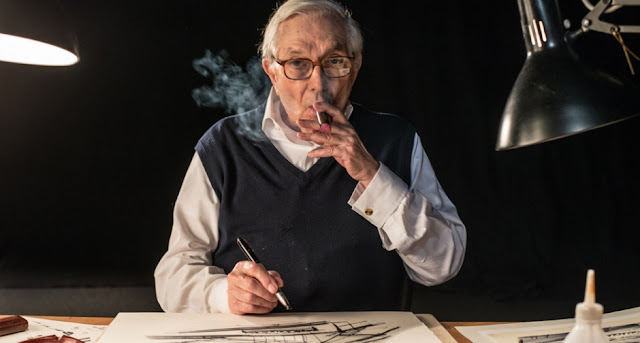 |
| Ken Adam |
On March 10, 2016, production designer Ken Adam died at the age of 95 in London, England. Over the course of his career, and specifically between the 1960's and 1980's, he was known for designing some of the most iconic set pieces for the early James Bond films as well as additional work for Stanley Kubrick on the films Dr. Strangelove and Barry Lyndon, the latter of which he won his first of two Oscars for. He leaves behind an impressive, inimitable body of work that lasted for over 40 years and continues to serve as some of the most iconic imagery in sci-fi and action film history.
Adam was born on February 5, 1921 in Berlin, Germany to a Jewish family that ran a successful high-fashion clothing store, founded in 1863, called S Adam. In the year 1934, Germany's Nazi Party came into power and began to signal the end for the Adam's family business. The company went bankrupt and the family had to consider fleeing the country. It was in England that Adam would get his education, attending the Bartlett School of Architecture, where he would major in architecture. During World War II, Adam was part of the Royal Air Force Volunteer Reserve and was one of only three German-born air pilots. While he had many exploits with them, he was also key in designing bomb shelters.
Adam started as a draughtsman in 1948 on This Was a Woman; of which he met his wife Maria Letizia while filming. However, he didn't receive credit for most of his early work until 1956 with Soho Incident. He had also worked on Best Picture winners Around the World in 80 Days (he received his first Oscar nomination for the film) and Ben-Hur, though again without any major recognition. He was also known to work for Robert Aldrich. He finally worked with Kubrick on Dr. Strangelove, where he was asked to design the war room as being "gleaming and sinister." Despite occasional collaborations from then on (Kubrick would occasionally for Adam without recognition), Adam turned down Kubrick for his next film 2001: A Space Odyssey. The reason was simple. Since Kubrick had been working with NASA for a year on the film, Adam felt that he was at a disadvantage and wouldn't work with him again until Barry Lyndon over 10 years later.
Among his biggest achievements in film is working on the James Bond films. He was responsible for the futuristic look of the franchise's first seven films. Starting with Dr. No in 1962, he worked on every film until Moonraker in 1979. With uncredited work by Kubrick, Bond film The Spy Who Loved Me featured a supertanker that was built on the world's largest sound stage at the time. His work on these seven films alone would be considered by critics to be just as integral to the film as the suit, music, or story. During this time, he also helped to design various props, including the car from Chitty Chitty Bang Bang. Still, it was Barry Lyndon that finally got him his first Oscar win for Best Art Direction. He didn't show up to the ceremony.
Over the course of his career, he was nominated five times. He finally won his second Oscar in 1995 for The Madness of King George, which he won with Carolyn Scott. In terms of acceptance speeches, he gave the familiar gratitude towards the cast and crew that he had worked with. This would also be his last nomination. In the remainder of his career, he only worked on a handful of projects. In 1999, he had an exhibit at Victoria and Alberta Museum that highlighted his contributions to making sets reminiscent of the Cold War. He was awarded an OBE in 2003 and also became a naturalized citizen of England around the same time. He was being recognized for his work in film.
Considering that James Bond is a franchise that continues to flourish, it's important to note the value that Adam brought to every scene. It is a perfect encapsulation of his work as a whole, of which he worked breathlessly to make iconic visuals that continue to inspire audiences and serve as the building blocks for one of cinema's longest lasting franchises. Very few can compare to his impressive body of work, and that's saying something. He also helped to shape the vision of Kubrick and even provided something visceral for the viewer. Most of what he touched can at least be described as memorable, and for that alone his legacy lives on as an impressive feat for film culture.
Considering that James Bond is a franchise that continues to flourish, it's important to note the value that Adam brought to every scene. It is a perfect encapsulation of his work as a whole, of which he worked breathlessly to make iconic visuals that continue to inspire audiences and serve as the building blocks for one of cinema's longest lasting franchises. Very few can compare to his impressive body of work, and that's saying something. He also helped to shape the vision of Kubrick and even provided something visceral for the viewer. Most of what he touched can at least be described as memorable, and for that alone his legacy lives on as an impressive feat for film culture.
No comments:
Post a Comment